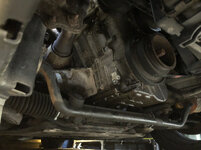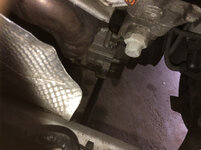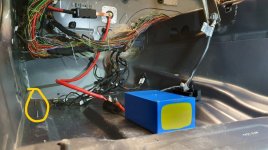You are using an out of date browser. It may not display this or other websites correctly.
You should upgrade or use an alternative browser.
You should upgrade or use an alternative browser.
Liam's Z4C race car project
- Thread starter Liam22
- Start date
Spotted an E86 out at Snett this weekend when I was working. Thought it may be of interest to you, believe it was in the Toyo Tyres Saloon Racing series.


Not sure on all the specs as I never got chance to bump into the team running it, but from having a nosey it's sat on Team Dynamics Pro Race 18x9J ET35 with R888R's in 255/35R18 all round. Not sure what lap times it was doing either, but can't imagine it would be far behind most non Evo E36 M3's.


Not sure on all the specs as I never got chance to bump into the team running it, but from having a nosey it's sat on Team Dynamics Pro Race 18x9J ET35 with R888R's in 255/35R18 all round. Not sure what lap times it was doing either, but can't imagine it would be far behind most non Evo E36 M3's.
Liam22 said:Thanks for sharing, Jono! I do know of that car, as I will be having the same roll cage kit fitted. It was built by the same outfit that run the ZC ars series.
No racing numbers on that car, so I think it was there just for show.
Nice, so Custom Cages but fitted by BDS? Where are they based? I noticed they hadn't cut out the bulkhead behind the seats like you have, but the cage still looked nicely fitted around it.
It was definitely running on Friday during practice
Made some progress on the electrics over the last couple of weekends.
Started by planning the battery relocation in more detail. The primary wiring goes like this:
Started by removing the battery cables. The pair of under-car cables weigh 2.8kg, the interior one is 2.2kg. And the battery itself, a whopping 19.5kg. Chasing the interior battery cable through the car meant that I had to open up the loom, so I took the opportunity to remove all of the redundant wiring that runs front-to-back. That's the audio, seat power, airbags, and misc stuff like tailgate release and heated rear window. There is still more to come, but the first pass totalled 4.3kg.
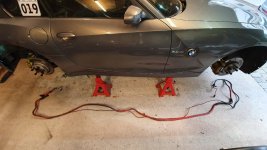
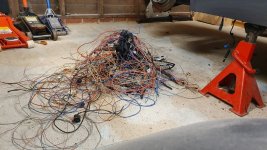
It's a nice feeling to chase back the rear wiring (like tailgate open sensor) from the back of the car, all the way to the fusebox. Even better when you can remove entire multi-connectors from the fusebox. Any wire left cut, and possibly carrying a live feed, was capped with heatshrink to avoid shorts.
If I were braver, I would unpick more of the loom now, but it's a time-consuming job and I will take a second pass when I'm ready to put the dash back in.
With the wiring reduced, I moved the OEM battery to the passenger footwell and jerry-rigged the battery cables to pick up the correct fuses. The bulkhead battery post that I fitted previously now connects up to the alternator/starter (unfused). From the same post, I attached the (shortened) engine bay power cable. The 100A fuse that feeds the engine bay power was replaced by a more substantial "mega fuse" of the same rating.
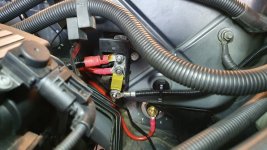
Back in the passenger footwell, the bulkhead post runs straight to the Lithium battery. The little motorcycle battery has tiny terminals, so I used a mega fuse holder (without fuse) to make a beefier terminal with a strip of copper which will make for a decent 'jump start' post if necessary. The battery negative cable will ultimately lead to the isolator (master switch) on the passenger sill, but for now it goes to body at the transmission tunnel.
The last piece of the puzzle is the feed to the fuse box. This uses a 250A fuse connected almost directly to the bulkhead post. Another short length of copper strip was used in preference to a 5cm length of battery cable. Nice and sturdy this way, too.
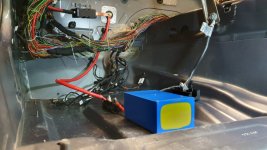
And it works! The tiny battery struggles a little to get the starter motor moving but then it speeds up and we're away.
Before and after diagrams (so I can remember how it goes!):
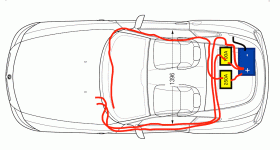
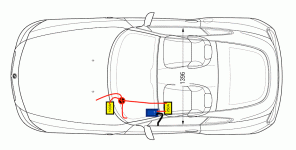
I have not weighed all of the new battery cables yet, but we're looking at a saving of 22-23kg. Projected weight is now very close to my 1200kg target.
Started by planning the battery relocation in more detail. The primary wiring goes like this:
Code:
+-----+ __________________ under car to alternator/starter (the really big cable)
| + |/-------[100A]----- under the car to engine power distribution box
| |\-------[250A]----- through the interior (driver's side), across bulkhead, to fuse box
| |
| - |-------- to body earth
+-----+Started by removing the battery cables. The pair of under-car cables weigh 2.8kg, the interior one is 2.2kg. And the battery itself, a whopping 19.5kg. Chasing the interior battery cable through the car meant that I had to open up the loom, so I took the opportunity to remove all of the redundant wiring that runs front-to-back. That's the audio, seat power, airbags, and misc stuff like tailgate release and heated rear window. There is still more to come, but the first pass totalled 4.3kg.


It's a nice feeling to chase back the rear wiring (like tailgate open sensor) from the back of the car, all the way to the fusebox. Even better when you can remove entire multi-connectors from the fusebox. Any wire left cut, and possibly carrying a live feed, was capped with heatshrink to avoid shorts.
If I were braver, I would unpick more of the loom now, but it's a time-consuming job and I will take a second pass when I'm ready to put the dash back in.
With the wiring reduced, I moved the OEM battery to the passenger footwell and jerry-rigged the battery cables to pick up the correct fuses. The bulkhead battery post that I fitted previously now connects up to the alternator/starter (unfused). From the same post, I attached the (shortened) engine bay power cable. The 100A fuse that feeds the engine bay power was replaced by a more substantial "mega fuse" of the same rating.

Back in the passenger footwell, the bulkhead post runs straight to the Lithium battery. The little motorcycle battery has tiny terminals, so I used a mega fuse holder (without fuse) to make a beefier terminal with a strip of copper which will make for a decent 'jump start' post if necessary. The battery negative cable will ultimately lead to the isolator (master switch) on the passenger sill, but for now it goes to body at the transmission tunnel.
The last piece of the puzzle is the feed to the fuse box. This uses a 250A fuse connected almost directly to the bulkhead post. Another short length of copper strip was used in preference to a 5cm length of battery cable. Nice and sturdy this way, too.

And it works! The tiny battery struggles a little to get the starter motor moving but then it speeds up and we're away.
Before and after diagrams (so I can remember how it goes!):


I have not weighed all of the new battery cables yet, but we're looking at a saving of 22-23kg. Projected weight is now very close to my 1200kg target.
Something I've been meaning to do for ages is fit a front cross member jacking point (as per the Z4M).
There is a M10 threaded hole in the cross member so I screwed a stud into it, refitted the undertray and tapped it with a hammer to make a witness mark. Removed the undertray then drilled a 50mm hole centred on the witness mark.
Measured the required depth at about 30mm and bought a short section of 50mm diameter nylon rod. Cut down to 30mm with a hacksaw and drilled a centre hole to fit an M10 bolt. Cutting a recess for the bolt head was the hardest part as the most suitable tool I had was a Dremel cutting disc used as a mill. Cue lots of melted nylon!
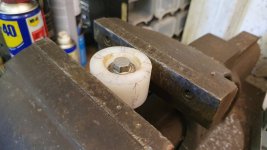
Works pretty well - I can now jack the car up using the new front jacking point and then the rear (adding jack stands under the sill at each step!).
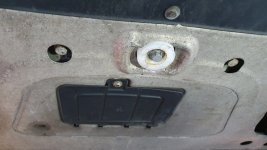
There is a M10 threaded hole in the cross member so I screwed a stud into it, refitted the undertray and tapped it with a hammer to make a witness mark. Removed the undertray then drilled a 50mm hole centred on the witness mark.
Measured the required depth at about 30mm and bought a short section of 50mm diameter nylon rod. Cut down to 30mm with a hacksaw and drilled a centre hole to fit an M10 bolt. Cutting a recess for the bolt head was the hardest part as the most suitable tool I had was a Dremel cutting disc used as a mill. Cue lots of melted nylon!

Works pretty well - I can now jack the car up using the new front jacking point and then the rear (adding jack stands under the sill at each step!).

Looks a nice neat jobLiam22 said:Something I've been meaning to do for ages is fit a front cross member jacking point (as per the Z4M).
There is a M10 threaded hole in the cross member so I screwed a stud into it, refitted the undertray and tapped it with a hammer to make a witness mark. Removed the undertray then drilled a 50mm hole centred on the witness mark.
Measured the required depth at about 30mm and bought a short section of 50mm diameter nylon rod. Cut down to 30mm with a hacksaw and drilled a centre hole to fit an M10 bolt. Cutting a recess for the bolt head was the hardest part as the most suitable tool I had was a Dremel cutting disc used as a mill. Cue lots of melted nylon!
20191027_120104.jpg
Works pretty well - I can now jack the car up using the new front jacking point and then the rear (adding jack stands under the sill at each step!).
20191027_120645.jpg
Lots of discussion on this over the years https://z4-forum.com/forum/viewtopic.php?f=2&t=60018&start=15terryo said:are you saying the M car has something like this jack point from factory? any idea why?
Mate, Neato job on the cabling... would love to have some guidance on what to remove and what needs to stay. any tips mate? mostly intrested in getting rid of the 2 huge looms that go rearward of the bulkhead and also the crap running along the trans tunnel. Ive got a week booked in from the missus next week to tackle some of that while I am on annual leave. Not in Dubai then by any chance are you so I can buy you a crap load of beer?

V.
V.
Thanks! Basically, I just unplugged everything I didn't want, and then chased all the cables back as far as possible (to the fusebox). But unless you have the dashboard removed the best you can do is get back to the footwells.
Took my time with the boot open sensor. One of the cables needs to be grounded to extinguish the "door open" warning light. I'll earth it beside the fuse box. I can tell you which one it is if you need it.
FWIW, the only necessary cable on the passenger side was for the wheel speed sensor, but that is for a RHD car.
Next week I'm in San Diego. Not back in Dubai until Feb
Took my time with the boot open sensor. One of the cables needs to be grounded to extinguish the "door open" warning light. I'll earth it beside the fuse box. I can tell you which one it is if you need it.
FWIW, the only necessary cable on the passenger side was for the wheel speed sensor, but that is for a RHD car.
Next week I'm in San Diego. Not back in Dubai until Feb
Finished off the front brake cooling. Bumper off and fog lamps removed, replaced with some generic brake ducts of approximately the same size. They were actually quite easy to fit, and didn't require too much fettling.
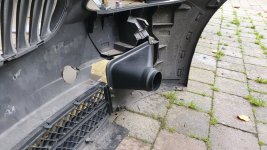
The big gap is not going to be great for airflow, so I made up thin aluminium plates to get as much air into the scoop as possible. Not pretty, but should do the job.
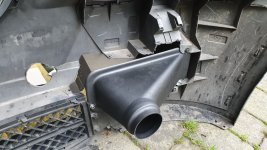
3" ducting then all the way from ducts to brake shields. It needs quite a convoluted route so it'll probably only be effective at quite high speed.
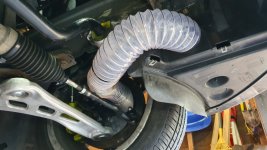
And that's the last job I can do before the roll cage goes in. So off it goes to Fabricage for the Custom Cages install!
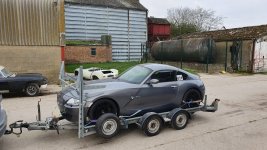

The big gap is not going to be great for airflow, so I made up thin aluminium plates to get as much air into the scoop as possible. Not pretty, but should do the job.

3" ducting then all the way from ducts to brake shields. It needs quite a convoluted route so it'll probably only be effective at quite high speed.

And that's the last job I can do before the roll cage goes in. So off it goes to Fabricage for the Custom Cages install!

